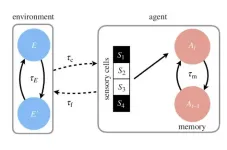(Press-News.org) A common yet underdiagnosed sleep disorder contributes to the development of dementia among adults — particularly women, a Michigan Medicine study suggests.
Investigators uncovered this by examining survey and cognitive screening data from more than 18,500 adults to determine the potential effect of known or suspected obstructive sleep apnea on the risk for dementia.
Obstructive sleep apnea is a chronic sleep disorder characterized by episodes disrupted or restricted breathing during sleep.
For all adults age 50 and older, having known obstructive sleep apnea or its symptoms — as people often do not know they have the problem — was associated with a higher chance of having signs or a diagnosis of dementia in coming years.
While the overall difference in those dementia diagnoses never rose above 5%, the association remained statistically significant even after researchers accounted for many other factors that can affect dementia risk, such as race and education.
At every age level, women with known or suspected sleep apnea were more likely than men to be diagnosed with dementia.
In fact, the rate of dementia diagnosis decreased among the men and grew larger for the women as they aged.
The results are published in SLEEP Advances.
“Our findings offer new insight into the role of a treatable sleep disorder on long-term cognitive health at the population level for both women and men,” said first author Tiffany J. Braley, M.D., M.S., neurologist, director of the Multiple Sclerosis/Neuroimmunology Division and co-founder of the Multidisciplinary MS Fatigue and Sleep Clinic at University of Michigan Health.
Reasons for the sex-specific differences in dementia diagnosis by sleep apnea status, researchers say, are not yet known. However, they pose several possible explanations.
Women with moderate sleep apnea may have a greater risk of cardiovascular disease and are more likely to have insomnia, both of which can negatively impact cognitive function.
“Estrogen starts to decline as women transition to menopause, which can impact their brains,” said co-author Galit Levi Dunietz, Ph.D., M.P.H., an associate professor in the University of Michigan Department of Neurology and Division of Sleep Medicine.
“During that time, they are more prone to memory, sleep and mood changes that may lead to cognitive decline. Sleep apnea increases significantly post-menopause yet remains underdiagnosed. We need more epidemiologic studies to better understand how sleep disorders in women impact their cognitive health.”
Six million Americans have been officially diagnosed with sleep apnea, yet the disorder is believed to affect closer to 30 million people.
In a 2024 report, a Lancet Commission identified several modifiable risk factors that together account for around 40% of global dementia.
While sleep was not included as an official risk factor, the commission noted that sleep apnea “might be associated with dementia” and to consider adding screening questions about dementia for people with the sleep disorder.
Other modifiable risk factors for dementia include cardiovascular disease and mental health problems, both of which may be exacerbated by untreated sleep apnea.
“These potential harms caused by sleep apnea, many of which threaten cognitive performance and decline, highlight the importance of early diagnosis and treatment,” Braley said.
“Obstructive sleep apnea and resultant sleep deprivation and fragmentation are also associated with inflammatory changes in the brain that may contribute to cognitive impairment.”
The Michigan Medicine study used existing data from the Health and Retirement Study, an ongoing survey that is representative of Americans aged 50 and older.
“This study design cannot fully prove that sleep apnea causes dementia — that would likely require a randomized trial, over many years, to compare effects of sleep apnea treatment to the effects of no treatment,” said co-author Ronald D. Chervin, M.D., M.S., director of the Division of Sleep Medicine in the Department of Neurology at U-M Health.
“As it may be a long time if ever until such a trial occurs, backward-looking analyses such as ours, within large databases, may be among the most informative for years to come. In the meantime, the results provide new evidence that clinicians and patients, when making decisions about testing for sleep apnea and treating it, should consider the possibility that untreated sleep apnea causes or exacerbates dementia.”
Additional authors: Xiru Lyu, M.S., Paul C. Schulz, M.S., Henry L. Paulson, M.D., Ph.D., and Kerby Shedden, Ph.D., all of University of Michigan, and Riley Bove, M.D., of University of California San Francisco.
Funding/disclosures: This work was funded by National Institute on Aging R01AG074342 (Braley/Dunietz MPIs.)
Paper cited: “Sex-specific dementia risk in known or suspected obstructive sleep apnea: A 10-year longitudinal population-based study,” SLEEP Advances. DOI: 10.1093/sleepadvances/zpae077
END
Sleep apnea contributes to dementia in older adults, especially women
Women with known or suspected sleep apnea were more likely than men to have symptoms or a diagnosis of dementia at every age level
2024-10-31
ELSE PRESS RELEASES FROM THIS DATE:
The silk thread that can turn clothes into charging stations
2024-10-31
Imagine a sweater that powers electronics to monitor your health or charge your mobile phone while running. This development faces challenges because of the lack of materials that both conduct electricity stably and are well suited for textiles. Now a research group, led by Chalmers University of Technology in Sweden, presents an ordinary silk thread, coated with a conductive plastic material, that shows promising properties for turning textiles into electricity generators.
Thermoelectric textiles convert temperature differences, for example between our bodies and the surrounding ...
Glaucoma drug shows promise against neurodegenerative diseases, animal studies suggest
2024-10-31
A drug commonly used to treat glaucoma has been shown in zebrafish and mice to protect against the build-up in the brain of the protein tau, which causes various forms of dementia and is implicated in Alzheimer’s disease.
Researchers in the UK Dementia Research Institute at the University of Cambridge screened more than 1,400 clinically-approved drug compounds using zebrafish genetically engineered to make them mimic so-called tauopathies. They discovered that drugs known as carbonic anhydrase inhibitors – of which the glaucoma drug methazolamide is one – clear tau build-up and reduce signs of the disease in zebrafish and mice carrying the mutant forms of tau ...
Human proteins identified that explain inter-individual differences in functional brain connectivity
2024-10-31
BIRMINGHAM, Ala. – A long-standing goal of neuroscience is to understand how molecules and cellular structures on a microscale give rise to communication between brain regions at the macroscale. A study published in Nature Neuroscience now identifies, for the first time, hundreds of brain proteins that explain inter-individual differences in functional connectivity and structural covariation in the human brain.
“A central goal of neuroscience is to develop an understanding of the brain that ultimately describes the mechanistic basis of human cognition and behavior,” said Jeremy Herskowitz, Ph.D., associate professor in the University of Alabama at Birmingham ...
A newly developed algorithm shows how a gene is expressed at microscopic resolution
2024-10-31
They say a picture is worth a thousand words.
A new method, developed by University of Michigan researchers, creates images that are worth many gigabytes of data, which could revolutionize the way biologists study gene expression. Seq-Scope, developed by Jun Hee Lee, Ph.D., Hyun Min Kang, Ph.D., and their colleagues, was first described in Cell in 2021 as the first method to analyze gene expression at sub micrometer-scale spatial resolution.
To compare, a single human hair ranges from 20 to 200 micrometers in width.
The team has since improved Seq-Scope, making it more versatile, ...
Why elephants never forget but fleas have, well, the attention span of a flea
2024-10-31
Researchers at the Complexity Science Hub and Santa Fe Institute have developed a model to calculate how quickly or slowly an organism should ideally learn in its surroundings. An organism’s ideal learning rate depends on the pace of environmental change and its life cycle, they say.
Every day, we wake to a world that is different, and we adjust to it. Businesses face new challenges and competitors and adapt or go bust. In biology, this is a question of survival: every organism, from bacteria to blue whales, faces the challenge of adapting to environments that ...
Childhood neglect associated with stroke, COPD, cognitive impairment, and depression
2024-10-31
Toronto, ON, – New research from the University of Toronto found that childhood neglect, even in the absence of childhood sexual abuse and physical abuse, is linked with a wide range of mental and physical health problems in adulthood.
“While a large body of research has established the detrimental impact of childhood physical and sexual abuse on adult health outcomes, much less is known about whether neglect, in the absence of abuse, has similar negative outcomes,” said first author, Linxiao Zhang, a PhD student at the Factor-Inwentash Faculty of Social Work (FIFSW) at the University of Toronto. “Our research underlines the importance of health professionals ...
Landmark 20-year study of climate change impact on permafrost forests
2024-10-31
In perhaps the first long-term study of CO2 fluxes in northern forests growing on permafrost, an Osaka Metropolitan University-led research team has found that climate change increased not only the sources of carbon, but also the CO2 sinks.
The 20-year observation from 2003-2022 in the interior of Alaska showed that while CO2 sinks turned into sources during the first decade, the second decade showed a nearly 20% increase in CO2 sinks.
Graduate School of Agriculture Associate Professor Masahito Ueyama and colleagues found that warming led to wetness, which in turn aided the growth of black spruce trees. During photosynthesis, the growing trees were using the increasing ...
Researchers take broadband high-resolution frequency combs into the UV
2024-10-31
WASHINGTON — Researchers have developed a new ultrafast laser platform that generates ultra-broadband ultraviolet (UV) frequency combs with an unprecedented one million comb lines, providing exceptional spectral resolution. The new approach, which also produces extremely accurate and stable frequencies, could enhance high-resolution atomic and molecular spectroscopy.
Optical frequency combs — which emit thousands of regularly spaced spectral lines — have transformed fields like metrology, spectroscopy and precision timekeeping via optical atomic clocks, earning the 2005 Nobel Prize in Physics.
The ...
Not going out is the “new normal” post-Covid, say experts
2024-10-31
Compared with just before the Covid-19 pandemic, people are spending nearly an hour less a day doing activities outside the home, behaviour that researchers say is a lasting consequence of the pandemic.
A new study published in the peer-reviewed Journal of the American Planning Association reveals an overall drop since 2019 of about 51 minutes in the daily time spent on out-of-home activities, plus an almost 12-minute reduction in time spent on daily travel such as driving or taking public transportation.
The analysis, based on a survey of 34,000 Americans, ...
Study shows broader screening methods help prevent spread of dangerous fungal pathogen in hospitals
2024-10-31
Study Shows Broader Screening Methods Help Prevent Spread of Dangerous Fungal Pathogen in Hospitals
Screening high-risk patients for Candida auris allows for early detection and implementation of infection control measures to prevent hospital outbreaks
Arlington, Va. — October 31, 2024 — A new study published today in the American Journal of Infection Control (AJIC) describes the outcome of a shift in hospital screening protocols for Candida auris, a dangerous and often drug-resistant fungal pathogen that spreads easily in hospital environments. A comparison of screening results and patient outcomes before ...
LAST 30 PRESS RELEASES:
Tracing the quick synthesis of an industrially important catalyst
New software sheds light on cancer’s hidden genetic networks
UT Health San Antonio awarded $3 million in CPRIT grants to bolster cancer research and prevention efforts in South Texas
Third symposium spotlights global challenge of new contaminants in China’s fight against pollution
From straw to soil harmony: International team reveals how biochar supercharges carbon-smart farming
Myeloma: How AI is redrawing the map of cancer care
Manhattan E. Charurat, Ph.D., MHS invested as the Homer and Martha Gudelsky Distinguished Professor in Medicine at the University of Maryland School of Medicine
Insilico Medicine’s Pharma.AI Q4 Winter Launch Recap: Revolutionizing drug discovery with cutting-edge AI innovations, accelerating the path to pharmaceutical superintelligence
Nanoplastics have diet-dependent impacts on digestive system health
Brain neuron death occurs throughout life and increases with age, a natural human protein drug may halt neuron death in Alzheimer’s disease
SPIE and CLP announce the recipients of the 2025 Advanced Photonics Young Innovator Award
Lessons from the Caldor Fire’s Christmas Valley ‘Miracle’
Ant societies rose by trading individual protection for collective power
Research reveals how ancient viral DNA shapes early embryonic development
A molecular gatekeeper that controls protein synthesis
New ‘cloaking device’ concept to shield sensitive tech from magnetic fields
Researchers show impact of mountain building and climate change on alpine biodiversity
Study models the transition from Neanderthals to modern humans in Europe
University of Phoenix College of Doctoral Studies releases white paper on AI-driven skilling to reduce burnout and restore worker autonomy
AIs fail at the game of visual “telephone”
The levers for a sustainable food system
Potential changes in US homelessness by ending federal support for housing first programs
Vulnerability of large language models to prompt injection when providing medical advice
Researchers develop new system for high-energy-density, long-life, multi-electron transfer bromine-based flow batteries
Ending federal support for housing first programs could increase U.S. homelessness by 5% in one year, new JAMA study finds
New research uncovers molecular ‘safety switch’ shielding cancers from immune attack
Bacteria resisting viral infection can still sink carbon to ocean floor
Younger biological age may increase depression risk in older women during COVID-19
Bharat Innovates 2026 National Basecamp Showcases India’s Most Promising Deep-Tech Ventures
Here’s what determines whether your income level rises or falls
[Press-News.org] Sleep apnea contributes to dementia in older adults, especially womenWomen with known or suspected sleep apnea were more likely than men to have symptoms or a diagnosis of dementia at every age level




